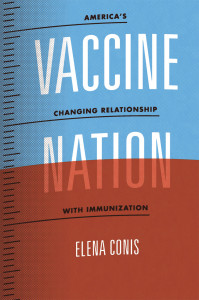Elena Conis, Vaccine Nation: America’s Changing Relationship with Immunization (Chicago: The University of Chicago Press, 2015), 353 pages.
Review by Andrew J. Forney
Many people probably purchased Elena Conis’ Vaccine Nation for that special anti-vaxxer in their lives. The book’s publication dovetailed nicely with the growing hue and cry against self-professed anti-vaccination advocate Jenny McCarthy and her ilk. Scientists tied an outbreak of measles among U.S. children during early 2015 to an un-vaccinated child who visited Disneyworld with their family in conjunction with the theme park’s holiday rush. Social media erupted with vitriol towards those that would endanger the health of others for quasi-ideological (and largely unproven) beliefs about the danger of vaccines. Conis’ work, subtitled “America’s Changing Relationship with Immunization,” would surely provide the last necessary bit of evidence to quell these obviously-addled helicopter parents. Right?
Not exactly. Vaccine Nation, a history of Americans and their shots, sketches a far-more nuanced portrait of immunization history than a simplistic “good/bad” binary. While she readily admits that vaccines have helped prevent a multitude of illnesses, she also points out that many factors went into the decision to mandate the vaccination of American citizens, particularly children. Conis ultimately argues that vaccines and immunization therapy never existed within a vacuum. Rather, the development, use, and criticism of vaccines all happened within a socio-political construct that reflected more about Americans and their hopes and fears than objective and unbiased science. As the events of the last half of the twentieth century transformed this aforementioned construct, American citizens’ views on immunization also changed. Cold War battles, the growing value of children, the revolution in the family, the conservative counter-revolution – all of these events impacted how parents viewed immunization, Conis claims, and the reverberations echo into today.
Methodologically, Conis builds on the work of famous historian of medicine Charles Rosenberg. He argued that diseases are “framed” by the social context in which they appear.[1] HIV/AIDS, for instance, first appeared in the United States shortly after the election of Ronald Reagan. The conservative small-government ideology and rising evangelicalism of his presidency had little room for the disease’s initial victims – homosexuals, immigrants, and drug addicts. To a rising generation of ideological adherents, each of these subgroups represented a unique failure in American society, a sin to be cleansed of. Not until the demography of AIDS patients expanded to include hemophiliacs, celebrities, and “normal” Americans did society begin to change its perception of the disease and the people who suffered from it.[2] Conis uses Rosenberg’s  “framing theory” in her work, but in reverse; now, the vaccines that prevent disease are the objects framed by society.
“framing theory” in her work, but in reverse; now, the vaccines that prevent disease are the objects framed by society.
Kennedy’s Vaccination Assistance Act, signed into law during 1962, provided federal assistance in dollars and advisors to states in order that all citizens could be vaccinated against several diseases, chief among them polio. As Conis points out, “Policy, here, took its shape from existing technologies. Indeed, the act was remarkable because it gave Americans something they hadn’t asked for” (20). No popular cry for a vaccine to prevent childhood diseases animated this legislation. Rather, vaccines existed at the whim of three separate but interrelated trends: Cold War anxiety, rapid bio-medical development, and Great Society liberalism. Each of these trends saw vaccination as proof positive of American exceptionalism, be it in the face of communist subversion or urban poverty. It mattered little that rates of morbidity for these diseases had steadily fallen since the 1950s, nor did the fact that periodic outbreaks still occurred after the implementation of the program. The goal was to prevent all diseases and overcome nature through science and preparation. And the government, in all of its mid-century consensus liberal glory, appeared to provide the means to achieve this halcyon dream.
The dream faded during the 1970s. This decade, marked by the credibility gap over Vietnam, the fracture over Watergate, and the disillusionment over the energy crisis, left citizens doubting the efficacy of government, let alone its ability to eradicate disease. The immunization initiatives of the Carter administration, while still intending to protect all American children from childhood ailments, now favored a rhetoric of “personal and parental responsibility” over governmental largesse. And in a time of pending fiscal austerity, the administration sold their plan as cost-effective, saving taxpayers the cost of paying for chronic illnesses with a pinprick (literally and figuratively). But, by keeping the scope of the initiative narrow and the expectations low, Carter’s initiative provided a “plan [that] vaccinated children against real threats, but did little to address unresolved issues about vaccines and the policies guiding their use” (103).
These unresolved issues dealt primarily with the dual anxieties of vaccine safety and mandates. A growing chorus of opposition rose during the 1970s, giving voice to an ever-increasing amount of people that viewed immunizations, and the government’s requirement to get them, with suspicion. Looking backwards from the twenty-first century, we tend to view anti-vaccine advocates as espousing a libertarian ideology, one that questions the right of the government to tell its citizens what they must put into their bodies. Conis acknowledges this strain of anti-vaccine thought, but categorizes it as one strain of many, and not even the most prominent. She instead argues that the foundation of twenty-first century anti-vaccine thought owes more to an unexpected source: late-twentieth century progressive ideals.
Herein lies the most interesting and complex portion of Vaccine Nation. Conis charts the rise of the environmental and feminist movements alongside a growing anti-corporatist viewpoint in her narrative, claiming that these intellectual trends provided many anti-vaccine advocates compelling arguments against government-mandated immunizations. Feminists that had railed against patriarchal systems within health care now had children and sought to nurture them in a more holistic manner outside the confines of a stifled and male-dominated hierarchy. The “green” movement of the 1970s provided a rich literature that rejected man’s attempts to corral nature and turn it to its bidding. Vaccines represented humanity’s arrogance about nature at the microscopic level. And by the turn of the twenty-first century, an increasingly vocal critique of government-corporate collusion left many suspicious of large pharmaceutical companies and their supposedly benevolent campaigns. While liberal legislators and presidents sought to further expand federal immunization assistance, they often contended with a progressive critique that, at times, interwove with a libertarian narrative of undue governmental expansion. Both the Clinton and Obama administrations dealt with this new groundswell of anti-vaccine advocacy, one that used burgeoning social media to create cross-ideological linkages previously unthinkable.
The progressive anti-vaccine advocates brought us to this point, Conis would argue; they are the ones that bring their unvaccinated children to Disneyworld and give your infant the measles. While important in terms of immunization programs, her conclusions also speak to the inability to truly form a liberal consensus since 1980. Successful liberal politicians have had to scale back their legislative agendas or face scornful accusations of government overreach or fascist overbearance. Immunization policies, Conis rightfully points out, provide a bellwether to measure the balance between legislation and rhetoric. It remains to be seen if a similar groundswell of public opinion in favor of broad-scope immunization initiatives signals a political shift regarding the relationship between the government and its citizenry. As Vaccine Nation correctly claims, immunization programs are more about politics than medicine.
[1] Charles Rosenberg, “Disease in History: Frames and Framers,” in Milbank Quarterly, vol. 67, no. 1 (1989): 1-15; for a more expanded treatment, see Charles Rosenberg, The Cholera Years: The United States in 1832, 1849, and 1866 (Chicago: The University of Chicago Press, 1962).
[2] While not a perfect work, and suffering from some issues with aging and new scientific developments, Randy Shilts’ reporting on the initial years of the HIV/ADIS crisis charts the social perception of HIV/AIDS during the early 1980s; see Randy Shilts, And the Band Played On: Politics, People, and the AIDS Epidemic (20th Anniversary Edition) (New York: St. Martin’ Griffin, 2007).
Andrew Forney i s currently an assistant professor of American History at the United States Military Academy (West Point) and a PhD student at Texas Christian University. His dissertation is entitled, The Federalist Empire: Searching for Stability and Security in the Revolutionary Atlantic. His studies focus on the intersection of fear, disease, and politics in American history, particularly during the era of the Early Republic. He can be reached at [email protected].
s currently an assistant professor of American History at the United States Military Academy (West Point) and a PhD student at Texas Christian University. His dissertation is entitled, The Federalist Empire: Searching for Stability and Security in the Revolutionary Atlantic. His studies focus on the intersection of fear, disease, and politics in American history, particularly during the era of the Early Republic. He can be reached at [email protected].

One Thought on this Post
S-USIH Comment Policy
We ask that those who participate in the discussions generated in the Comments section do so with the same decorum as they would in any other academic setting or context. Since the USIH bloggers write under our real names, we would prefer that our commenters also identify themselves by their real name. As our primary goal is to stimulate and engage in fruitful and productive discussion, ad hominem attacks (personal or professional), unnecessary insults, and/or mean-spiritedness have no place in the USIH Blog’s Comments section. Therefore, we reserve the right to remove any comments that contain any of the above and/or are not intended to further the discussion of the topic of the post. We welcome suggestions for corrections to any of our posts. As the official blog of the Society of US Intellectual History, we hope to foster a diverse community of scholars and readers who engage with one another in discussions of US intellectual history, broadly understood.
Either Conis or Forney has set this up with a bit of a straw-man argument: everyone I’ve seen discuss the anti-vaccination movement for the last ten years knows that the core of the resistance started with liberal/progressive/environmental/natural advocate. It’s a cliche of the genre. It also ignores the way in which religious and libertarian movements have used their arguments for their own ends (sometimes opportunistically, sometimes because their purposes overlap, as in the burgeoning Christian Organic movement).